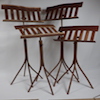I am having a devil of a time trying to make a zero clearance insert. I guess it's my general lack of router experience giving me grief.
I have an old Craftsman 113-xxxxxx table saw. It has the thin .090" thick insert. I am trying to make /practice making insert blanks with my home made router table and a flush trim bit. I had made 2 inserts from 1/4" thick laminate flooring. I user my pattern bit to copy the aluminum OEM insert, and then using a rabbit bit, undercut the laminate so the insert fir flush in the saw table. Had a problem with the router bit pulling out of the chuck(chuck was not properly tightened) and ruined the first 2. If I had installed a 8" saw blade to cut the initial arc in the blank, I wouldn't have destroyed them.
So, managed to make 2 more blanks from laminate flooring and 2 from a scrap piece of Masonite. Had a time getting my router adjusted to the correct depth to follow the patterns. Rather than struggle adjusting the router height to the OEM insert, I used the laminate blanks as the pattern for the thinner Masonite.
Had issues with the double stick tape also. Lowe's had 2 types of double stick tape, a thick rubbery one that was labeled 30# strength, and a clear one that was labeled 5# strength. I bought he rubbery one, I think I should have got the lighter one. I had a difficult time getting the patterns off the blanks without breaking them, but reusing the pattern with the same tape allowed the pattern to slip on the blank. Destroyed a blank that way...
I will save one of each type blank for further patterns(all out of material to make any more). I will also go back and get the lighter tape, and some more material for blank inserts.
Any tricks I'm missing for setting up the pattern on the roughed out blank?
I set the blank and pattern on the saw table, plus a couple of shims of thick tablet cardboard to adjust the plunge of the router for depth to get the bearing to ride on the pattern. Router must be removed from the table to adjust... Someday I'll have a router with a height adjust that can be accessed while in the table!
Chuck





 Reply With Quote
Reply With Quote



